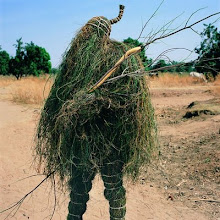pollen
My heart lurched. I could have squashed or injured the queen with my carelessness. The chance of her being on that frame was so small I did not even consider it a risk. But from now on I will assume she could be anywhere in the hive and to act like she might be on any frame I pull out.
I got some good pictures of her wandering around while Peter S. held the frame in the sunlight for me. She is dead center in the picture below. Notice how she is elongated and the color of polished wood rather than golden and striped like the worker bees.
The Queen!
We set her aside in an empty hive box out of the way from harm and continued our inspection. In particular, I wanted to see those supercedure cells in case they had hatched. The brood pattern was healthy. There were a few drones (male bees) wandering around but I did not get a picture of them.
About halfway through the hive we spotted the queen cells and had Peter S. look at them to tell us if they were new or already hatched. He could not tell but had us look inside to note that there was no egg or larvae at the bottom surrounded by royal jelly so most likely they were old. A beekeeper can predict the behavior of the hive by noting where the queen cells are located. If they are hanging off the bottom of the frame they are swarm cells and the hive is preparing to fly the coop, taking your workforce and honey producers along with it. The beekeeper can scrape those swarm cells off in an attempt to discourage the bees from swarming.
If the cells are more in the center of the frame like these are, the hive is making a new queen for itself to succeed the current queen who may be laying poorly, injured or dead. It is best to leave those cells alone. Or, if you see plenty of eggs and larvae and a laying queen you can take that frame out of the colony and place it in a new empty box along with some frames of brood and nurse bees to make a brand new colony. That is what we were hoping to do with this colony but since the queen cells were not in use we decided to just leave the hive alone.
Queen supercedure cells
We had the entire colony cracked open and spread out all over the bee yard. Each of us had a frame of bees in our hands. I was sorting through some boxes to find extra deep frames when Peter S. again yelled out that we had a problem. He gathered us around and showed us a cracked brood cell and that is when I smelled it. Foulbrood. It smells rotten, like really old dirty laundry, or rotting bugs and fermented honey. I thought I had smelled it earlier when we were sorting through some of the frames filled with honey but I just thought it was something on my gloves or some other funk. I should have spoken up.
Then all hell broke loose. We had stuff strewn all over the yard and now we realized that we had no way of knowing for sure if it came out of the sick hive or was leftover from working with the healthy hive. The reason we needed to know is that all frames in the sick hive had to be destroyed and all the boxes needed to be scorched. We had just made a lot of work for ourselves.
There was a bit of a kerfuffle while we threw out ideas for how to fix this problem. In the end we decided to shake all the bees into a new empty box of frames with new wax foundation and have them start over from scratch. We put down one deep with empty frames and one super with drawn comb so the queen would have somewhere to begin laying as soon as the workers cleaned out the comb.
The first shake rained a shower of contaminated nectar into the new boxes. So then we had to shake out the nectar onto the ground and then the bees into the hive. It was heartbreaking to see all the beautiful comb and brood and nectar go into the big black trash bags. All that work just thrown away. I ran in the house to get the antibiotic, Terramyacin, and mixed it with powdered sugar to treat the hive.
powdered antibiotic on the ends of each frame
After everything was put back together Charley collected all the hive tools so he could sanitize them. I went back and boiled up some 1:1 sugar syrup, waited for it to cool and poured it into a ziplock bag. I put one ziplock bag into each hive and poked holes in it so they could get to the sugar water. Feeding them this sugar water will give them the energy to build out all the new comb they will need to build up their population again.






No comments:
Post a Comment